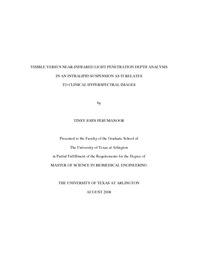
ATTENTION: The works hosted here are being migrated to a new repository that will consolidate resources, improve discoverability, and better show UTA's research impact on the global community. We will update authors as the migration progresses. Please see MavMatrix for more information.
Show simple item record
| dc.contributor.author | Perumanoor, Tinsy John | en_US |
| dc.date.accessioned | 2008-09-17T23:35:15Z | |
| dc.date.available | 2008-09-17T23:35:15Z | |
| dc.date.issued | 2008-09-17T23:35:15Z | |
| dc.date.submitted | July 2008 | en_US |
| dc.identifier.other | DISS-2258 | en_US |
| dc.identifier.uri | http://hdl.handle.net/10106/1138 | |
| dc.description.abstract | We determine the penetration depth of near-infrared and visible light in a tissue phantom model using various image processing techniques and chemometrics and use these results to demonstrate the application of a multimodal hyperspectral imaging system for monitoring blood perfusion in amputation wounds. It is capable of performing a noninvasive, in vivo, quantitative analysis of human tissue in a clinical environment, in terms of the percent saturation of oxyhemoglobin. The instrument majorly consists of near-infrared and visible charge coupled devices (CCDs), lenses, liquid crystal tunable filters (LCTFs) for both the CCDs attached to their respective lenses, and a broad band light source. A 1% intralipid suspension, which mimics the skin-tissue interface and india ink, a good absorber of light are used to create the phantom model and experiments are done using this model to determine the penetration depth of near-infrared and visible light, by collecting hyperspectral image cubes using the hyperspectral instrument and analyzing it. Different methods of analyses are done on the image data cubes collected and the results prove that the near-infrared light penetrates deeper into tissues than visible. This result is used to demonstrate the ability of the hyperspectral imager to clinically monitor human lower limb amputation wounds and determine the perfusion of oxygenated blood in it. In other words, it can monitor amputation wounds based on the level of oxyhemoglobin saturation in the tissues. | en_US |
| dc.description.sponsorship | Zuzak, Karel | en_US |
| dc.language.iso | EN | en_US |
| dc.publisher | Biomedical Engineering | en_US |
| dc.title | Visible Versus Near-infrared Light Penetration Depth Analysis In An Intralipid Suspension As It Relates To Clinical Hyperspectral Images | en_US |
| dc.type | M.S. | en_US |
| dc.contributor.committeeChair | Zuzak, Karel | en_US |
| dc.degree.department | Biomedical Engineering | en_US |
| dc.degree.discipline | Biomedical Engineering | en_US |
| dc.degree.grantor | University of Texas at Arlington | en_US |
| dc.degree.level | masters | en_US |
| dc.degree.name | M.S. | en_US |
| dc.identifier.externalLink | https://www.uta.edu/ra/real/editprofile.php?onlyview=1&pid=61 | |
| dc.identifier.externalLinkDescription | Link to Research Profiles | |
Files in this item
- Name:
- umi-uta-2258.pdf
- Size:
- 4.254Mb
- Format:
- PDF
- Name:
- VA_Consent_form.pdf
- Size:
- 62.78Kb
- Format:
- PDF
This item appears in the following Collection(s)
Show simple item record



